Lesson 10 | Infinitives
Grammar Point 1: Present (imperfective) Infinitives
Introduction to Greek Infinitives
An infinitive is a verbal noun. This means that it has some verbal characteristics and some noun characteristics. Like verbs, infinitives have tense-form (present, aorist, etc.) and voice. Remember that since infinitives are non-indicative, they communicate aspect and not time. Infinitives take their time from the context.
Like nouns, infinitives can take the article, function as the object of a preposition, and even serve as the main verb’s subject or direct object.
There are four important rules to note here:
- Without the article, infinitives are adverbial (they describe the main verb). With the article, infinitives act like nouns.
- When infinitives take the article, the article is always neuter.
- When an infinitive takes a distinct subject, that subject will be in the accusative case.
- When articular infinitives are part of a prepositional phrase, they often have a particular meaning (we will learn more about this later in the lesson).
Let’s look at a couple examples from the Greek NT.
Εμοὶ γὰρ τὸ ζῆν Χριστὸς καὶ τὸ ἀποθανεῖν κέρδος. For to me to go on living is Christ, and to die is gain. —Philippians 1:21
I bolded the two infinitives in this sentence. Note three things about this sentence. First, both infinitives have a nominative, neuter, singular article. When infinitives take the article, the article is always neuter.
Second, both infinitives are acting like nouns. Each infinitive is the subject of its respective clause. Both clauses are verbless with an implied “is.”
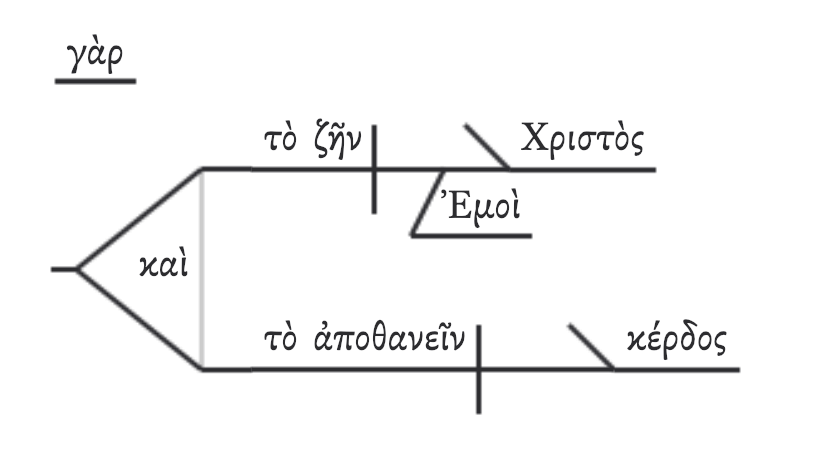
Third, note that both infinitives also communicate aspect even as they function like nouns. τὸ ζῆν is a present, active, infinitive from ζάω. So, it communicates imperfective aspect. Paul portrays his living from within as the action happens: “to be living” or “to go on living.” τὸ ἀποθανεῖν is an aorist, active, infinitive from ἀποθνῄσκω. So, it communicates perfective aspect. Paul summarizes the whole action from the outside: “to die.”
Let’s look at another example:
Χριστὸς Ἰησοῦς ἦλθεν εἰς τὸν κόσμον ἁμαρτωλοὺς σῶσαι Christ Jesus came into the world to save sinners —1 Timothy 1:15
Once again, I bolded the infinitive. Note three things about this infinitive. First, notice that, like a verb, σῶσαι takes a direct object: ἁμαρτωλοὺς.
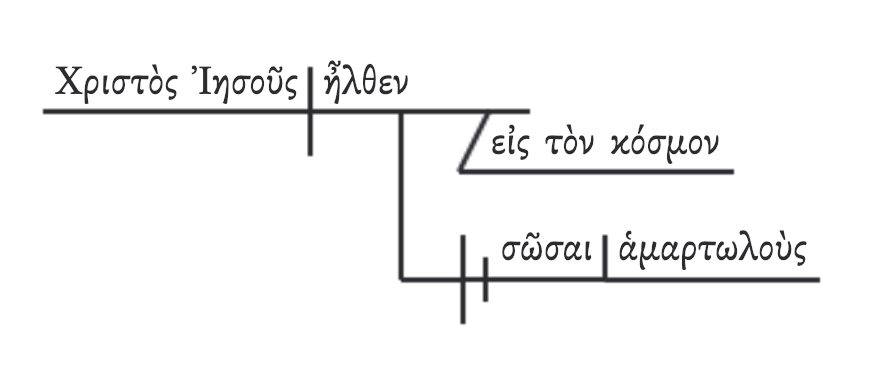
Second, look at how the infinitive functions adverbially to tell us more about the main verb. In this sentence, σῶσαι explains the purpose of ἦλθεν. Why did Jesus come? He came in order to save sinners.
Third, pay attention to what the tense-form communicates. Since σῶσαι (like all infinitives) is not in the indicative mood, it communicates aspect and not time. The infinitive draws its time from the main verb.
I hope you do not feel overwhelmed at this point. You do not need to master all this information right now. It will become more familiar to you as you work through this lesson. For now, remember three things:
- Infinitives are verbal nouns.
- Like verbs, infinitives communicate aspect and voice. They can also take subjects and objects like main verbs.
- Like nouns, infinitives can function as the subject or object of a main verb. They can also take a neuter article.
Present (imperfective) Infinitives
Present infinitives are imperfective infinitives. We call them “present” infinitives because most grammars use this terminology. However, do not be confused by this name. Present infinitives do not communicate time. They communicate imperfective aspect. So, we could just call them imperfective infinitives.
We need to learn two forms for present infinitives: (1) the present active infinitive and (2) the present middle or passive infinitive. Since infinitives do not have person or case, they have fewer forms than other kinds of verbs.
Like we did with participles, focus on learning key features for the present infinitives. Then, look at the example verb to help you see how these features work.
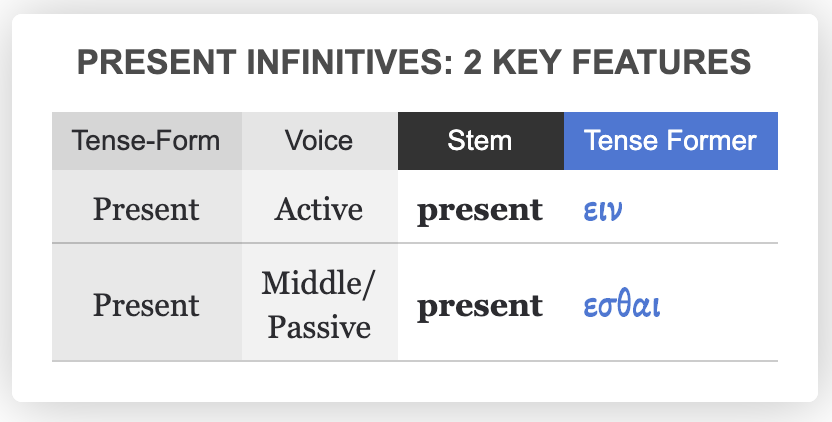
λυείν λύεσθαι
Examples from the Greek NT
ὅθεν καὶ σῴζειν εἰς τὸ παντελὲς δύναται τοὺς προσερχομένους δι᾿ αὐτοῦ τῷ θεῷ… And so, he is able to save completely those who come through him to God... —Hebrews 7:25
This is a complex but also beautiful sentence. Can you parse σῴζειν? We can see the present stem and the ειν tense former. Therefore, it is a present, active, infinitive from σῴζω. Since it is a present infinitive, it communicates imperfective aspect. However, it draws its timing from the main verb (δύναται). We could translate this infinitive as "to save" or "to go on saving" to communicate its imperfective aspect.
This sentence is a bit complex. So, let’s look at a diagram to help us draw out two further observations.
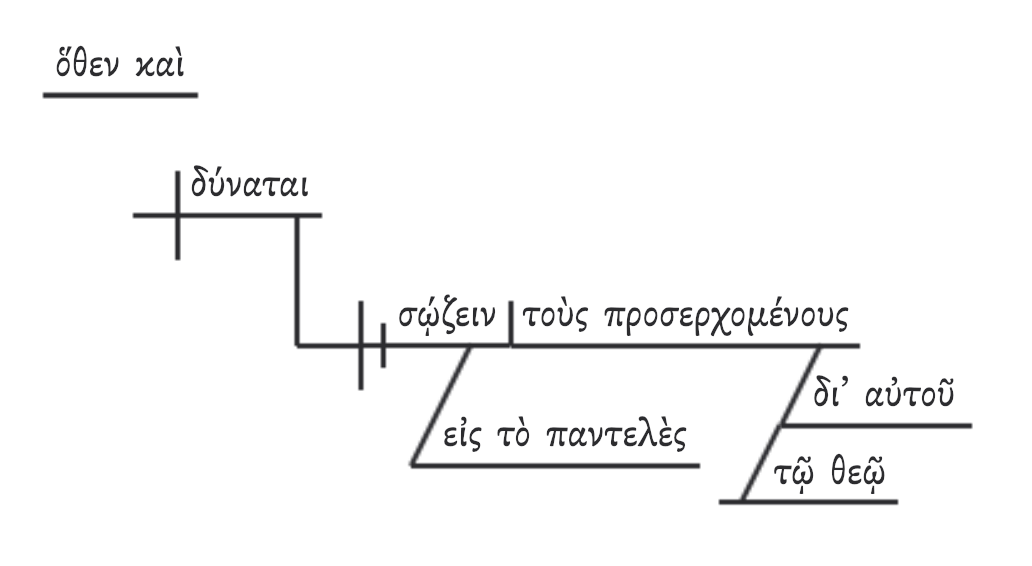
This diagram clarifies two ways that σῴζειν functions in this sentence. First, look at how σῴζειν relates to the main verb (δύναται). σῴζειν completes this verb’s idea. δύναται means “he is able,” which leaves us asking, “he is able to do what?” The infinitive completes the main verb’s idea: “he is able to save.”
Second, notice that the infinitive has its own modifier and direct object. Look at the diagram, the prepositional phrase εἰς τὸ παντελές describes the extent of the infinitive’s action. He is not just able to save. Jesus is able to save completely. σῴζειν also has its own direct object: τοὺς προσερχομένους (can you parse this participle?). Who is he able to save completely? He is able to save completely those who come through him to God.
Let’s look at another example.
μέλλει γὰρ ὁ υἱὸς τοῦ ἀνθρώπου ἔρχεσθαι ἐν τῇ δόξῃ τοῦ πατρὸς αὐτοῦ μετὰ τῶν ἀγγέλων αὐτοῦ For the Son of Man is destined to come in the glory of his Father with his angels. —Matthew 16:27
Can you parse ἔρχεσθαι? Look at its two key features. It has the present tense stem (ἐρχ) and the εσθαι tense former. It is a present, middle infinitive from ἔρχομαι. I parsed this verb as a middle voice verb even though the form could be middle or passive because this verb normally occurs in the middle voice.
Now, how is this infinitive functioning? Let’s take a look at the diagram for this verse.
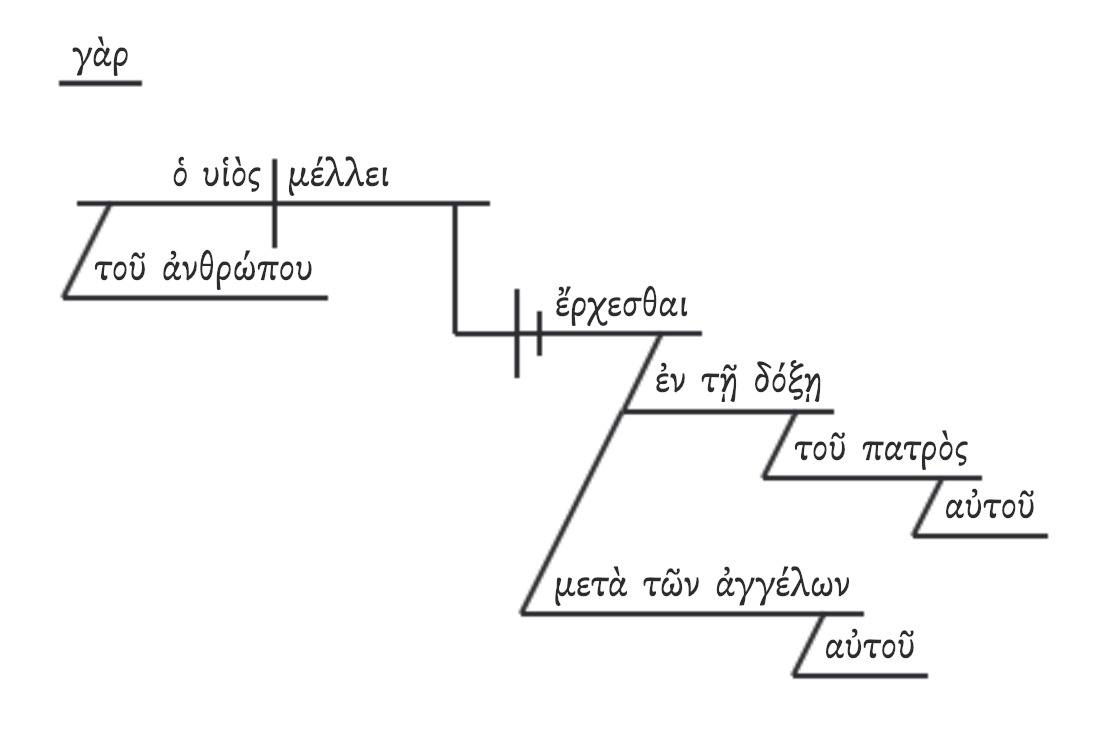
Once again, the infinitive completes the main verb’s idea. Here μέλλει means “he is destined,” and it leaves us asking: “He is destined to what?” ἔρχεσθαι completes the verbal action: “He is destined to come.”
Also, look at how the two prepositional phrases describe the infinitive’s action further. He is going to come (1) in the glory of his Father (2) with his angels.
Now, let’s look at one final example.
καὶ ἀπέστειλεν αὐτοὺς κηρύσσειν τὴν βασιλείαν τοῦ θεοῦ… And he sent them to preach the Kingdom of God… —Luke 9:2
Can you parse κηρύσσειν? Note its two key features: (1) it has the present stem and (2) it has the ειν tense former. It is a present, active, infinitive from κηρύσσω. Now, how is it functioning?
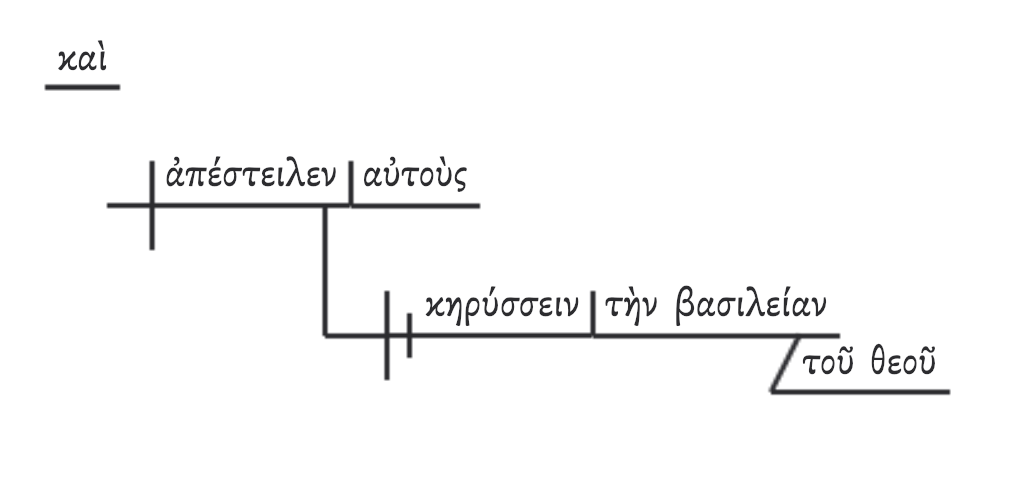
The infinitive is describing the verb. Unlike the previous two examples, the main verb expresses a complete idea: “He sent them.” So, what does the infinitive explain about this action? The infinitive explains why he sent them: “He sent them to preach the Kingdom of God.”
Before moving on to aorist infinitives, practice parsing present infinitives by using this quizlet.